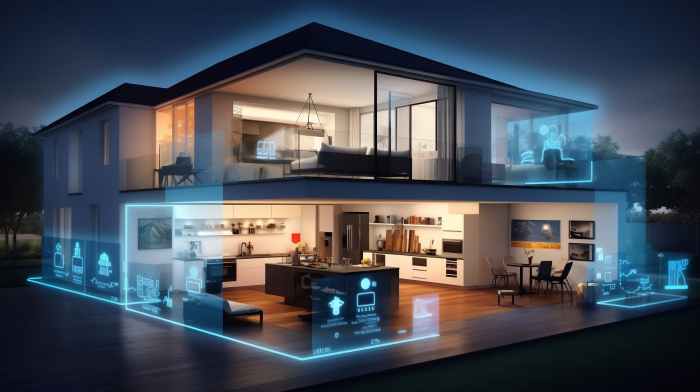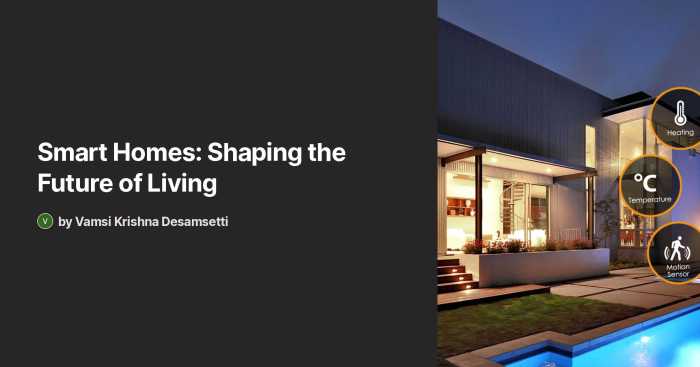Exploring the impact of smart homes on daily living, this introduction sets the stage for a fascinating discussion on how technology is revolutionizing our homes. From automation to energy efficiency, the way we live is evolving with the integration of smart devices.
As we delve deeper into the world of smart homes, we uncover the ways in which convenience, sustainability, security, and future innovations are shaping the way we interact with our living spaces.
 Automation plays a crucial role in smart homes, streamlining daily tasks and enhancing convenience for residents. Through the integration of advanced technology, smart homes can automate various processes to make living more efficient and comfortable.
. These systems enable homeowners to generate their electricity and even sell excess energy back to the grid, promoting a more sustainable and environmentally friendly lifestyle.
Automation plays a crucial role in smart homes, streamlining daily tasks and enhancing convenience for residents. Through the integration of advanced technology, smart homes can automate various processes to make living more efficient and comfortable.
. These systems enable homeowners to generate their electricity and even sell excess energy back to the grid, promoting a more sustainable and environmentally friendly lifestyle.
 Smart home systems offer unparalleled convenience and efficiency, but it is crucial to address the security and privacy risks associated with these technologies. As smart devices become more prevalent in our daily lives, safeguarding our personal information and ensuring the protection of our homes from cyber threats are paramount.
Smart home systems offer unparalleled convenience and efficiency, but it is crucial to address the security and privacy risks associated with these technologies. As smart devices become more prevalent in our daily lives, safeguarding our personal information and ensuring the protection of our homes from cyber threats are paramount.
 In conclusion, the influence of smart homes on our daily lives is undeniable. As technology continues to advance, the possibilities for enhancing our living experiences are endless. Embracing these innovations can truly transform the way we live and interact with our surroundings.
In conclusion, the influence of smart homes on our daily lives is undeniable. As technology continues to advance, the possibilities for enhancing our living experiences are endless. Embracing these innovations can truly transform the way we live and interact with our surroundings.
Overview of Smart Homes
Smart homes are residences equipped with a range of devices and systems that automate tasks and provide enhanced control over functions such as lighting, heating, security, and entertainment. These interconnected devices can be remotely monitored and managed through a smartphone or voice commands, offering convenience, energy efficiency, and safety to homeowners.Popular Smart Home Devices and Benefits
- Smart Thermostats: Devices like Nest Learning Thermostat can adjust temperature settings based on user behavior, leading to energy savings and improved comfort.
- Smart Lighting Systems: Philips Hue bulbs allow users to control lighting remotely, set schedules, and create ambiance, reducing energy consumption and enhancing convenience.
- Smart Security Cameras: Options like Ring Video Doorbell provide real-time monitoring, motion detection, and alerts, enhancing home security and peace of mind.
- Voice Assistants: Devices such as Amazon Echo or Google Home enable voice commands for tasks like setting reminders, playing music, or controlling other smart devices, streamlining daily routines.
Impact of Smart Homes on Daily Living
Smart homes have revolutionized daily living by offering increased convenience, efficiency, and security. With the ability to remotely control various aspects of the home, residents can save time, reduce energy costs, and enhance overall comfort. Additionally, smart home devices contribute to a more connected and streamlined living experience, paving the way for a future where technology seamlessly integrates into our daily routines.Integration of Smart Home Technology
Smart home technology has revolutionized the way we interact with our living spaces, offering convenience, security, and efficiency. The integration of various smart home devices plays a crucial role in creating a seamless and interconnected experience for users.Comparison of Smart Home Ecosystems
- Amazon Alexa: Amazon's voice assistant allows users to control a wide range of smart devices using voice commands. Alexa can be integrated with numerous third-party devices and services, making it a versatile option for smart home automation.
- Google Home: Google's smart home ecosystem offers similar voice control capabilities through its Google Assistant. With compatibility with a variety of smart devices and services, Google Home provides a user-friendly experience for managing your smart home.
- Apple HomeKit: Apple's platform focuses on privacy and security, requiring HomeKit certification for devices to ensure compatibility. While the selection of HomeKit-compatible devices may be more limited, the ecosystem offers a seamless integration with Apple products for a cohesive smart home experience.
Importance of Compatibility and Interoperability
Compatibility and interoperability among smart devices are essential for ensuring a smooth and cohesive smart home ecosystem. When devices can communicate effectively with each other, users can create customized automation routines and scenarios that enhance their daily living experience. Investing in devices that are compatible with your chosen smart home ecosystem can help avoid compatibility issues and ensure a seamless integration.Automation and Convenience
 Automation plays a crucial role in smart homes, streamlining daily tasks and enhancing convenience for residents. Through the integration of advanced technology, smart homes can automate various processes to make living more efficient and comfortable.
Automation plays a crucial role in smart homes, streamlining daily tasks and enhancing convenience for residents. Through the integration of advanced technology, smart homes can automate various processes to make living more efficient and comfortable.
Automated Processes in Smart Homes
- Smart Lighting: Smart homes utilize sensors and timers to automatically adjust lighting based on natural light levels or the presence of occupants. This not only saves energy but also enhances convenience by eliminating the need to manually turn lights on and off.
- Smart Thermostats: Automated thermostats can learn residents' temperature preferences and adjust settings accordingly. This ensures optimal comfort while also reducing energy consumption by efficiently managing heating and cooling systems.
- Security Systems: Smart home security systems can automate tasks such as locking doors, arming alarms, and monitoring surveillance cameras. This provides homeowners with peace of mind and enhances overall safety and convenience.
Voice Assistants and AI Technology
- Voice Commands: Voice assistants like Amazon Alexa and Google Assistant enable users to control various aspects of their smart homes through simple voice commands. From adjusting the thermostat to turning on lights, voice control adds a new level of convenience to daily living.
- AI Integration: Artificial intelligence (AI) technology enhances the automation capabilities of smart homes by analyzing user behavior and patterns. AI assistants can anticipate residents' needs and preferences, making adjustments to settings or suggesting actions to optimize comfort and convenience.
Energy Efficiency and Sustainability
Smart homes play a crucial role in promoting energy efficiency and sustainability by utilizing advanced technology to reduce energy consumption and environmental impact.Smart Thermostats
Smart thermostats are equipped with sensors that learn the household's patterns and adjust the temperature accordingly. This feature helps in optimizing energy usage by heating or cooling the home only when needed, ultimately reducing energy wastage.Lighting Controls
Smart lighting systems allow users to control lights remotely through their smartphones or voice commands. By scheduling lighting patterns and dimming options, smart homes can minimize unnecessary energy usage and contribute to reducing electricity bills.Energy Monitoring Systems
Energy monitoring systems provide real-time data on energy consumption, allowing homeowners to track usage patterns and identify areas where energy can be saved. By being aware of their energy consumption, residents can make informed decisions to reduce their carbon footprint.Examples of Sustainability
Smart homes contribute to sustainability by incorporating renewable energy sources such as solar panels and smart gridsSecurity and Privacy in Smart Homes
 Smart home systems offer unparalleled convenience and efficiency, but it is crucial to address the security and privacy risks associated with these technologies. As smart devices become more prevalent in our daily lives, safeguarding our personal information and ensuring the protection of our homes from cyber threats are paramount.
Smart home systems offer unparalleled convenience and efficiency, but it is crucial to address the security and privacy risks associated with these technologies. As smart devices become more prevalent in our daily lives, safeguarding our personal information and ensuring the protection of our homes from cyber threats are paramount.
The Importance of Cybersecurity in Smart Home Systems
With the interconnected nature of smart home devices, the risk of cyber attacks and breaches is a significant concern. Hackers can exploit vulnerabilities in these devices to gain access to sensitive data or even control aspects of your home. Implementing robust cybersecurity measures is essential to prevent unauthorized access and protect your privacy.Potential Privacy Risks Associated with Smart Devices
Smart devices collect vast amounts of data about our habits, preferences, and routines. This data can be exploited by third parties for targeted advertising or even malicious purposes if not properly secured. Privacy risks include unauthorized access to cameras or microphones, data breaches, and the potential for personal information to be shared without consent.Tips on Securing Smart Home Devices and Maintaining Privacy
- Regularly update firmware and software on all smart devices to patch vulnerabilities and improve security.
- Use strong, unique passwords for each device and enable two-factor authentication whenever possible.
- Secure your home network with a firewall and encryption to prevent unauthorized access.
- Disable unused features on smart devices that may pose security risks, such as remote access or voice control.
- Review privacy settings and permissions for each device to control what data is collected and shared.
Future Trends and Innovations
As smart home technology continues to advance at a rapid pace, several key trends and innovations are shaping the future of daily living. From IoT integration to AI advancements, smart homes are evolving to meet changing consumer needs and offer increased convenience and efficiency.IoT Integration
The integration of Internet of Things (IoT) devices in smart homes is becoming increasingly prevalent. These interconnected devices allow for seamless communication and automation, enabling users to control various aspects of their home remotely. From thermostats to lighting systems, IoT integration is revolutionizing the way we interact with our living spaces.AI Advancements
Artificial Intelligence (AI) is playing a significant role in the evolution of smart home technology. AI-powered virtual assistants, such as Amazon's Alexa and Google Assistant, are becoming more sophisticated and intuitive, providing personalized experiences for users. These advancements in AI are enhancing the automation and control capabilities of smart homes, making daily tasks more efficient and streamlined.Consumer Needs
Smart homes are continuously adapting to meet the changing needs and preferences of consumers. From energy efficiency solutions to enhanced security features, smart home technology is becoming more customizable and tailored to individual lifestyles. The future of smart home automation lies in its ability to seamlessly integrate with our daily routines and anticipate our needs, ultimately enhancing the overall quality of daily living.Epilogue
 In conclusion, the influence of smart homes on our daily lives is undeniable. As technology continues to advance, the possibilities for enhancing our living experiences are endless. Embracing these innovations can truly transform the way we live and interact with our surroundings.
In conclusion, the influence of smart homes on our daily lives is undeniable. As technology continues to advance, the possibilities for enhancing our living experiences are endless. Embracing these innovations can truly transform the way we live and interact with our surroundings.






